Contents
- Agastya Ashram Mandir, Akole
- Ahilyadevi Holkar Smruti Stambh
- Ahmednagar Fort
- History
- Nizam Shahi Period (1490-1600)
- Later Period (1759-Present)
- Bagh Rauza
- Cavalry Tank Museum
- Chirki-Nevasa Archaeological Site
- Dhokeshwar Caves,Takli
- Farah Baksh Mahal
- Godad Maharaj Mandir
- Hasta-Behasta Mahal
- Historical Museum & Research Centre
- Hume Memorial Church, Ahilyanagar
- Architecture
- Jagdamba Devi Mandir, Rashin
- Kal Bhairavnath Mandir
- Kashi Vishwanath Mandir, Dhorja
- Madhi
- Pemgiri Banyan Tree, Sangamner
- Salabat Khan’s Tomb
- Shiv Mandir, Vriddheshwar
- Shri Datta Mandir
- Shri Sai Baba Mandir, Shirdi
- Sai Baba’s Life and Teachings
- Siddhivinayak Mandir
- Vishal Ganpati Mandir, Maliwada
- Sources
AHILYANAGAR
Cultural Sites
Last updated on 5 November 2025. Help us improve the information on this page by clicking on suggest edits or writing to us.
Agastya Ashram Mandir, Akole
The Agastya Ashram Mandir is situated in the Akole taluka of the district. Agastya Rishi, is one of the seven rishis (the Saptarishis) who is mentioned in many ancient texts such as the Vedas, Puranas, Ramayan, and Mahabharat. It is said that, for long, there were two mandirs that were dedicated to him since ancient times, one in Kashi and one here. Some believe that after coming from Kashi, he headed here and that’s when this place here was formed.
The Mandir’s origins are tied to a very famous legend that surrounds the rishi. One story that some locals often believe is that in the ancient times, when devis and devtas were battling the asurs, many asurs hid within the rivers. The devis and devtas, in turn, made a special request to Agastya Rishi to help them with the war; which led to the event of the “samudra prashan,” where the rishi swallowed the entire river. Many legends and stories, such as this, surrounding the rishi are captured in paintings which can be found within the mandir.
Ahilyadevi Holkar Smruti Stambh
The Ahilyadevi Holkar Smruti Stambh is a grand memorial which is situated in the village of Chaundi. The memorial commemorates the life of Rani Ahilyabai Holkar who is often dubbed as one of the “finest female rulers in Indian history.” Ahilyabai Holkar was the Queen of the Malwa Kingdom and is well known for her work across political, cultural, humanitarian, and social spheres. Notably, in recognition of her legacy and her connection to the region, the district was renamed on 31 May, 2023.
![A grand memorial that honors Punyashloka Ahilyadevi Holkar at Chaundi.[1]](/media/culture/images/maharashtra/ahilyanagar/cultural-sites/a-grand-memorial-that-honors-punya_jvGTCFo.png)
Ahilyabai Holkar was born in the village of Chaundi, though she would later rule mostly over regions in Madhya Pradesh and Khandesh, far from her birthplace. She came from the Dhangar (shepherd) community and was the daughter of the village Patil (head). The story of her marriage into the Holkar household is very remarkable; it is said that when passing by the village on his way to Pune, Malhar Rao Holkar, the ruler of Malwa and a commander in the army of Peshwa Bajirao I, spotted Ahilyabai at a mandir. Impressed by her character and temperament at such a young age, Malhar Rao got Ahilyabai married to his son.
The Ahilyabai Holkar memorial celebrates both the Queen and the village’s rich history. Situated along the Karjat-Jamkhed highway, the memorial features a striking statue of Ahilyabai visible from afar. Inside the complex, a series of sculptures tells her life story, from her birth in the village through her education, marriage, and years as a ruler. Each scene comes with an inscription that helps visitors understand the remarkable journey of the girl from this village who became Queen.
Ahmednagar Fort

Ahmednagar Fort in Bhingar is a historic fortification located in the city of Ahilyanagar. It was constructed in 1490 CE by Malik Ahmad Nizam Shah, the founder of the Nizam Shahi Dynasty and served as a royal residence and administrative center for the dynasty until 1600 CE. Notably, the fort was built alongside the establishment of the city of Ahilyanagar and in many ways was home to many significant moments in India’s history.
The fort is oval-shaped with a circumference of approximately 1.68 km, featuring 22 bastions. It is popularly referred to as ‘Bhuikot killa,’ (a Marathi term for a fort on the ground), distinctive for its location on flat plains, in contrast to the region's typical hilltop fortifications. Interestingly, locals say that the fort was originally encircled by water but now exists in a dry landscape filled with lush vegetation.
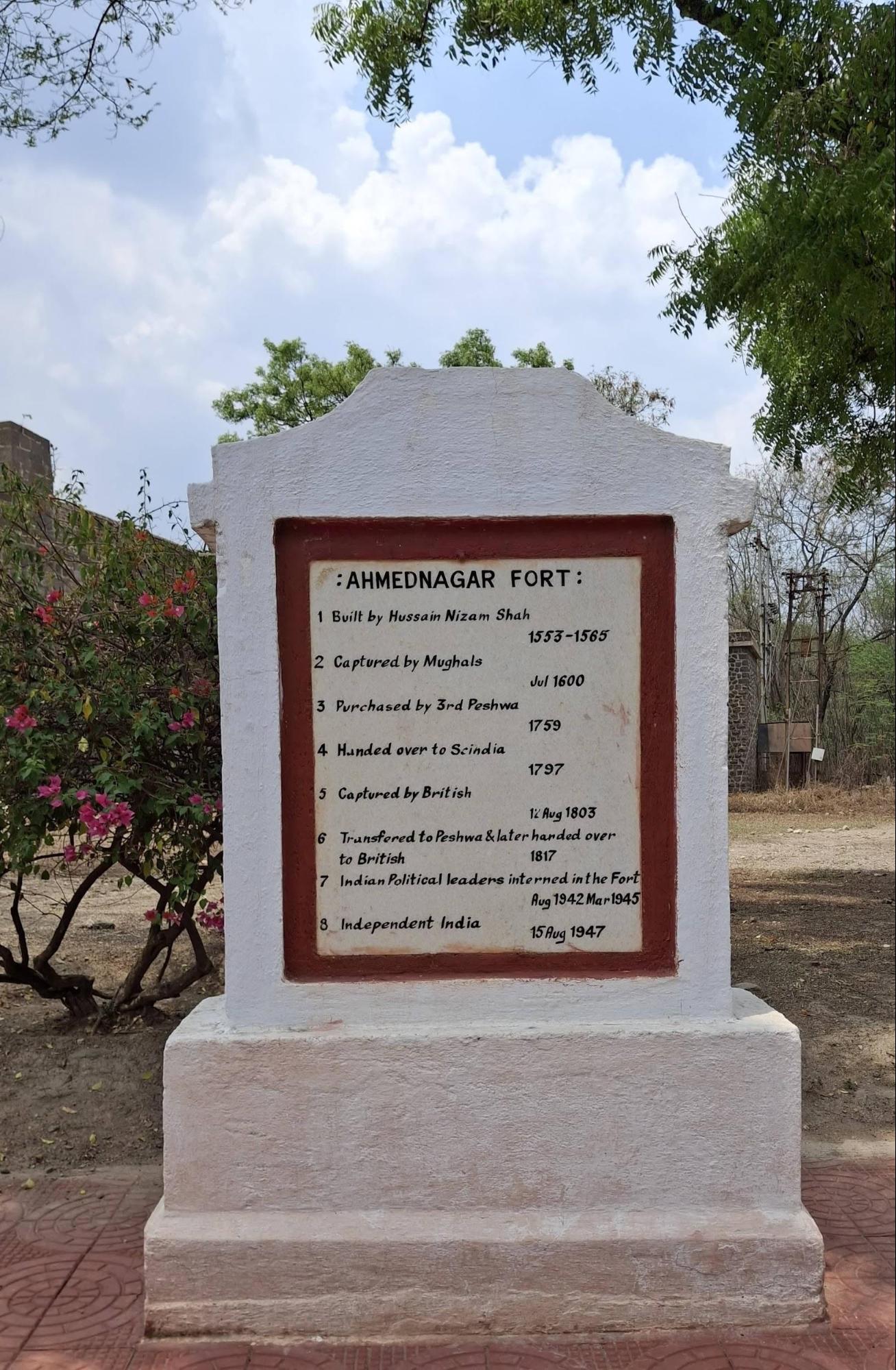
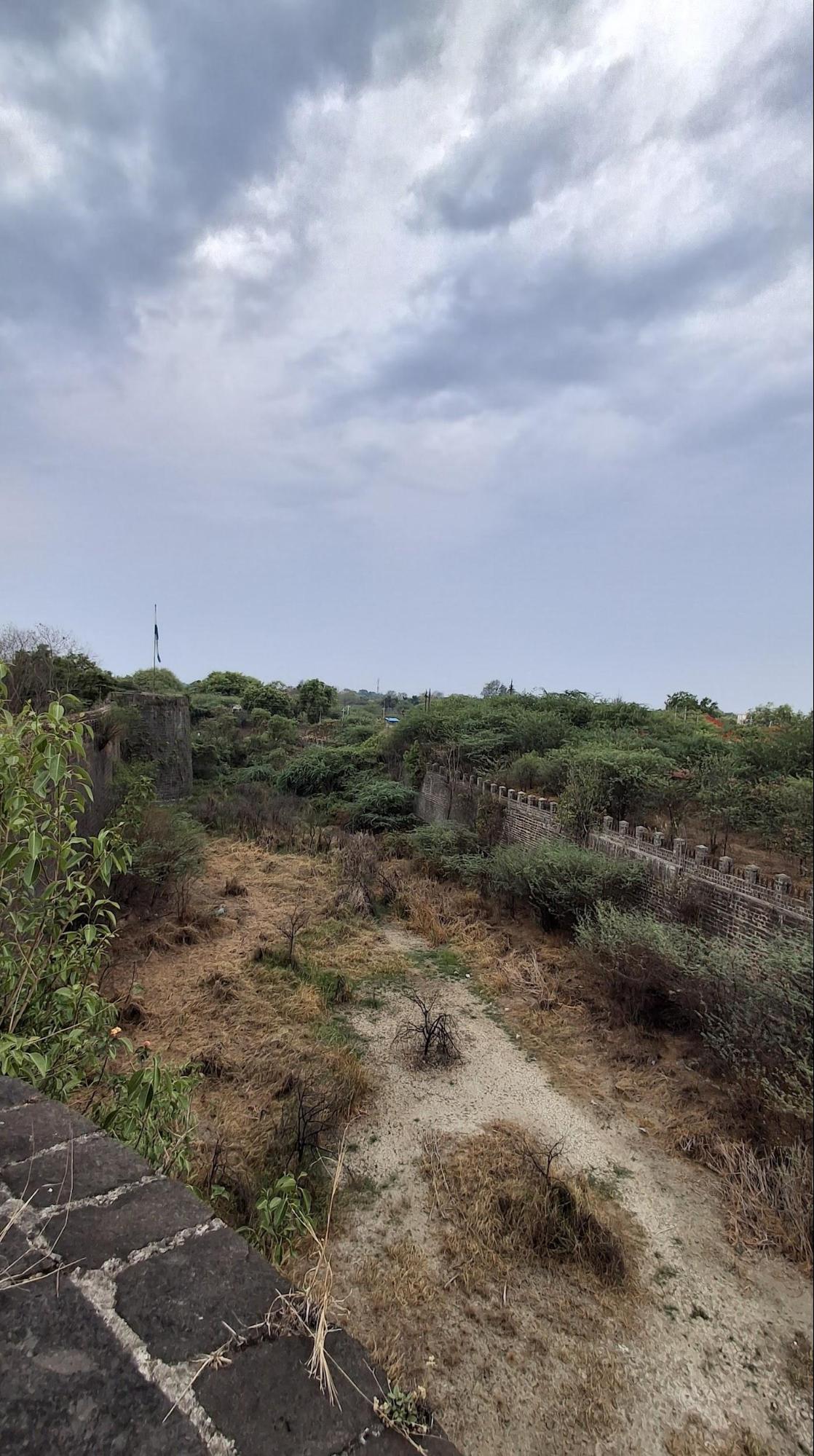
History
Nizam Shahi Period (1490-1600)
The history of the fort is intriguing and, as is typical of forts, reflects the shifting local political landscape and the rise and decline of various dynasties who have left their mark on the region. The creation of the fort itself is rooted in a pivotal moment in the history of Ahilyanagar City.
Notably, in 1490, Malik Ahmad, after defeating the Bahmani general Jahangir Khan, declared his independence and founded the Ahmadnagar Sultanate, a kingdom that ruled much of the district for centuries. He constructed an earthwork known as Bagh Nizam on the site where the fort stands today. According to the district colonial Gazetteer (1884), it was during the reign of Husain Nizam Shah (1553-1565) that the present structure of the fort was built, replacing the earlier fortifications with a more formidable design.
Remarkably, a significant, yet lesser-known period in the fort’s history involved Sultana Chand Bibi, daughter of Hussain Nizam Shah and regent of both Bijapur and Ahmadnagar Sultanates, often dubbed as the “warrior queen of Deccan.” According to the district colonial Gazetteer (1884) , her successful defense of the fort against a Mughal army led by Prince Murad, son of Emperor Akbar, and Mirzakhan, a Mughal viceroy, from November 1595 to February 1596. However, during a second siege in July 1600 by Prince Danyal, another son of Akbar, and the Mughal general Khan Khanan, the fort was captured due to an internal mutiny, during which Chand Bibi was allegedly killed by her own officers.
Later Period (1759-Present)
The fort changed hands several times over the following centuries. In 1759, it passed from Nizam Shahi to Maratha control, marking a significant shift in regional power dynamics. General Wellesley of the British Army captured it from Daulat Rao Sindhia, the Maratha Maharaja of Gwalior state and member of the House of Scindia on 12 October 1803, and by 1817, it came under full British control, remaining so until India’s independence in 1947. During British rule, the fort housed the Bombay Artillery and Laboratories for arms and ammunition manufacturing, with two historical howitzers (an artillery weapon) from 1829 and 1847 still standing at the entrance.
In 1832, the British added several structures to the fort, including a ‘zulta pul’ (hanging bridge) on the eastern side, showcasing the engineering innovations of the period. Although the bridge is currently in disrepair, restoration efforts are underway.


Another important structure nestled within the fort’s walls is the Leader’s Block. The Leader’s Block was, notably, once a royal prison. Notable prisoners from the medieval era included Maharani Yesubai, wife of Chhatrapati Sambhaji Maharaj, as well as the Maratha administrator Nana Fadnavis and the naval officer, Tulaji Angre.
The structure gained particular historical significance during the Quit India Movement (1942) when twelve prominent national leaders, including Pandit Nehru, Maulana Abul Kalam Azad, and Sardar Vallabhai Patel, were detained here, who played a pivotal role in India’s freedom struggle.

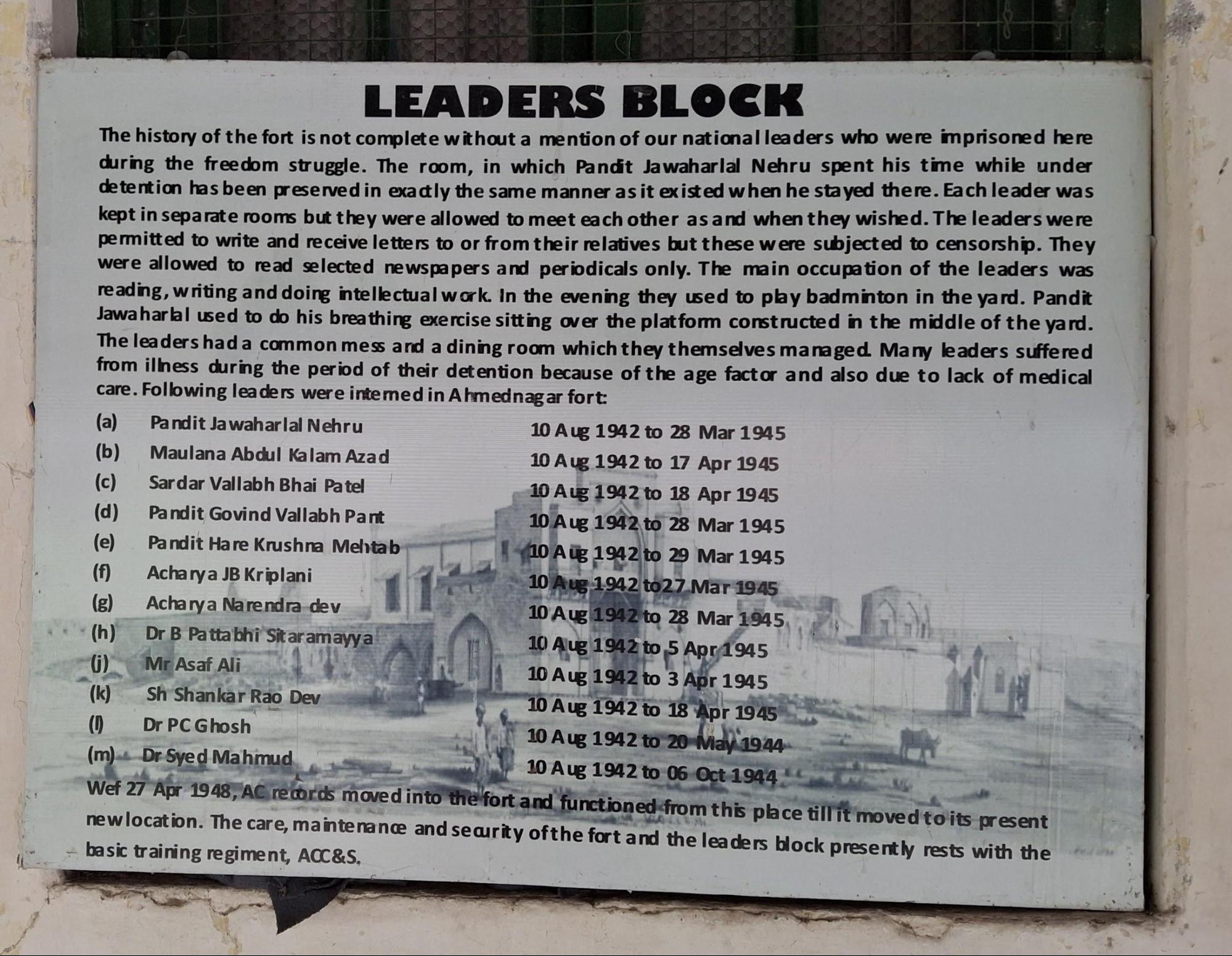
Though kept in separate rooms, according to the interpretive panel at the site, these leaders could meet at will. They were allowed to write and receive censored letters from family and read select newspapers and periodicals. Their days were filled with reading, writing, and intellectual pursuits, and they played badminton in the evenings. They managed a communal mess and dining area, however many suffered health issues due to their age and inadequate medical care.
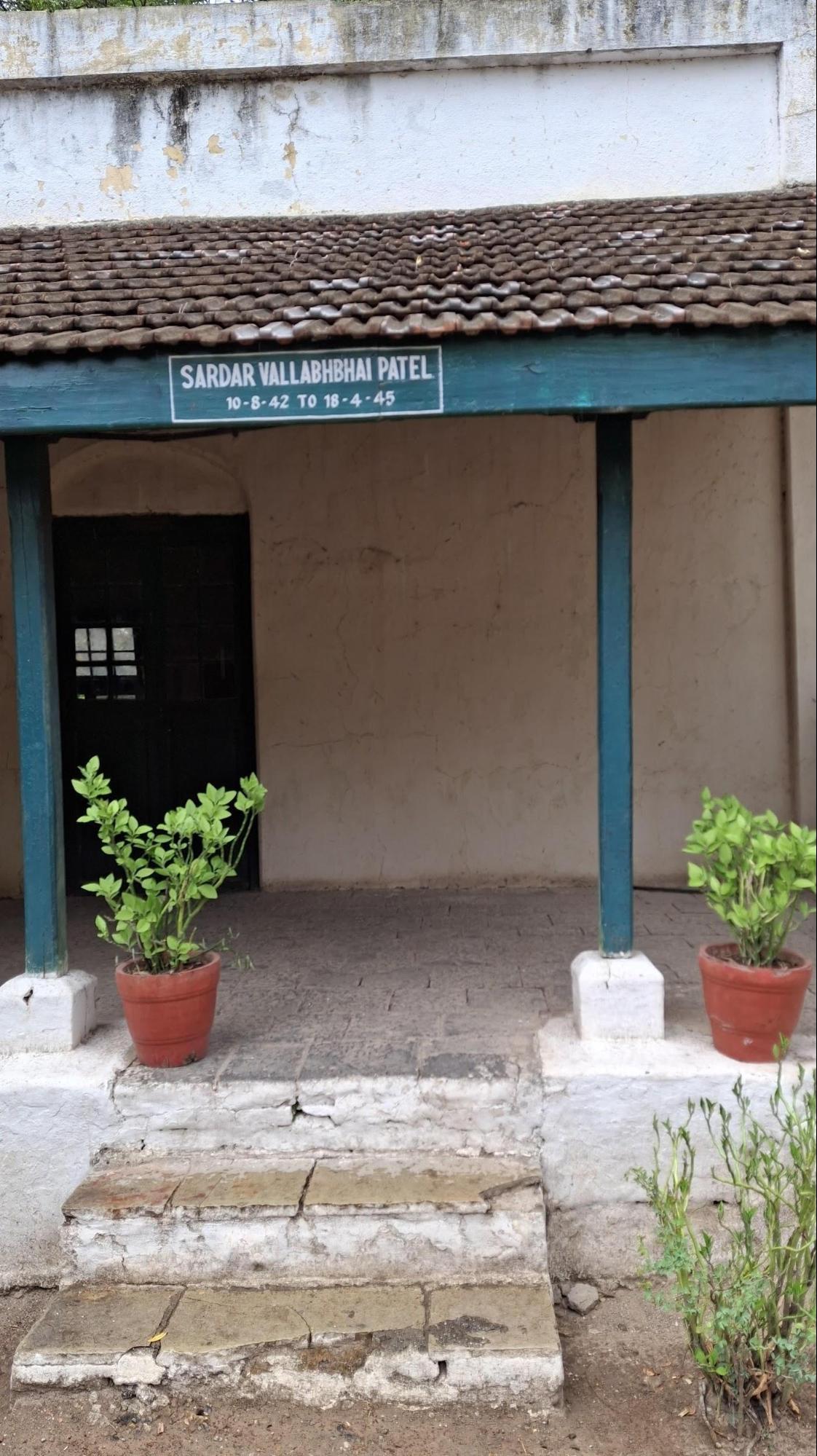
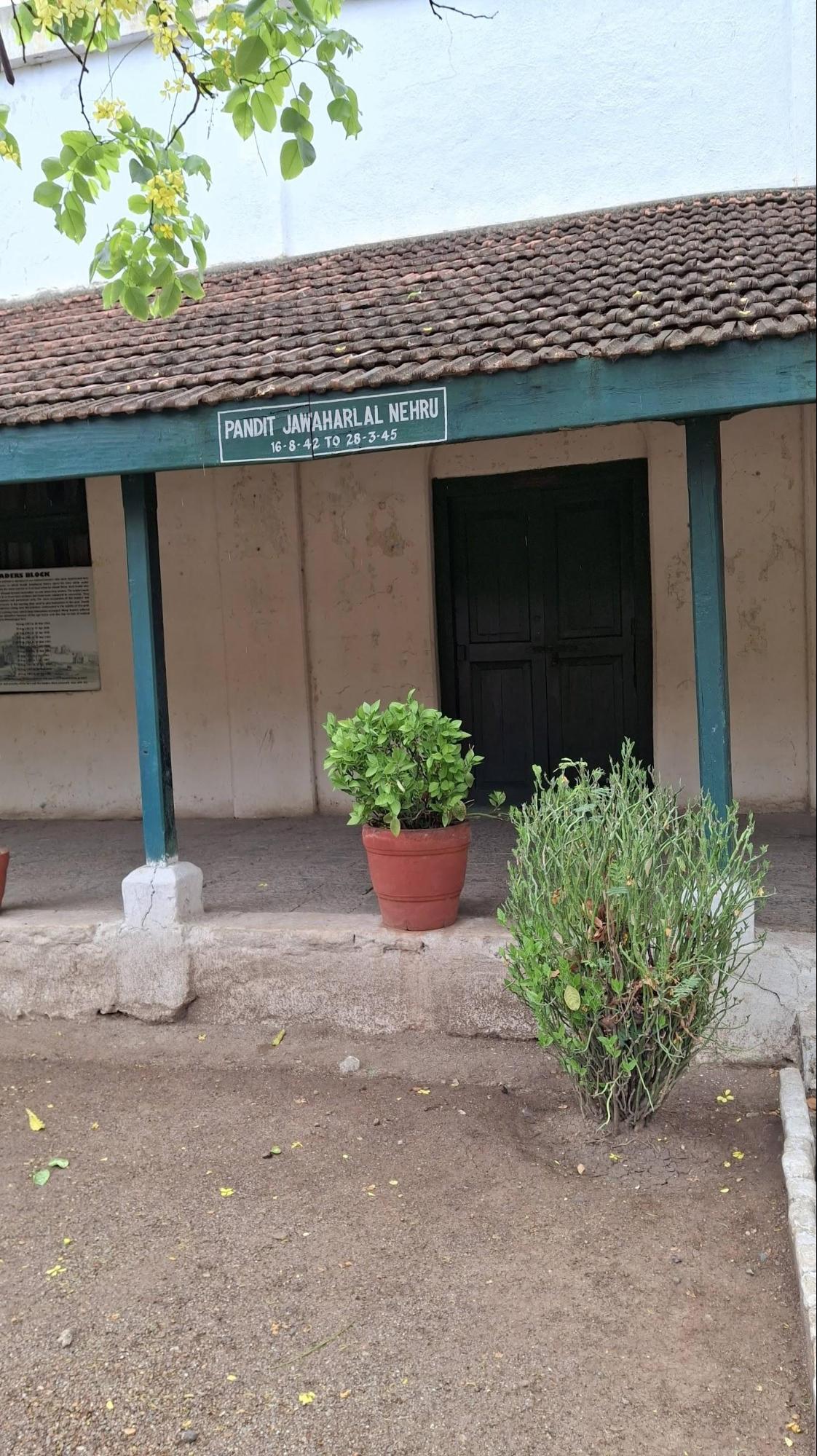


Notably, it was during this period of imprisonment that Jawaharlal Nehru penned his magnum opus, ‘The Discovery of India’, between April to September 1944. The room where he was held remains preserved, with every detail untouched, offering a glimpse into the period when one of India’s foremost leaders shaped his vision for the nation.
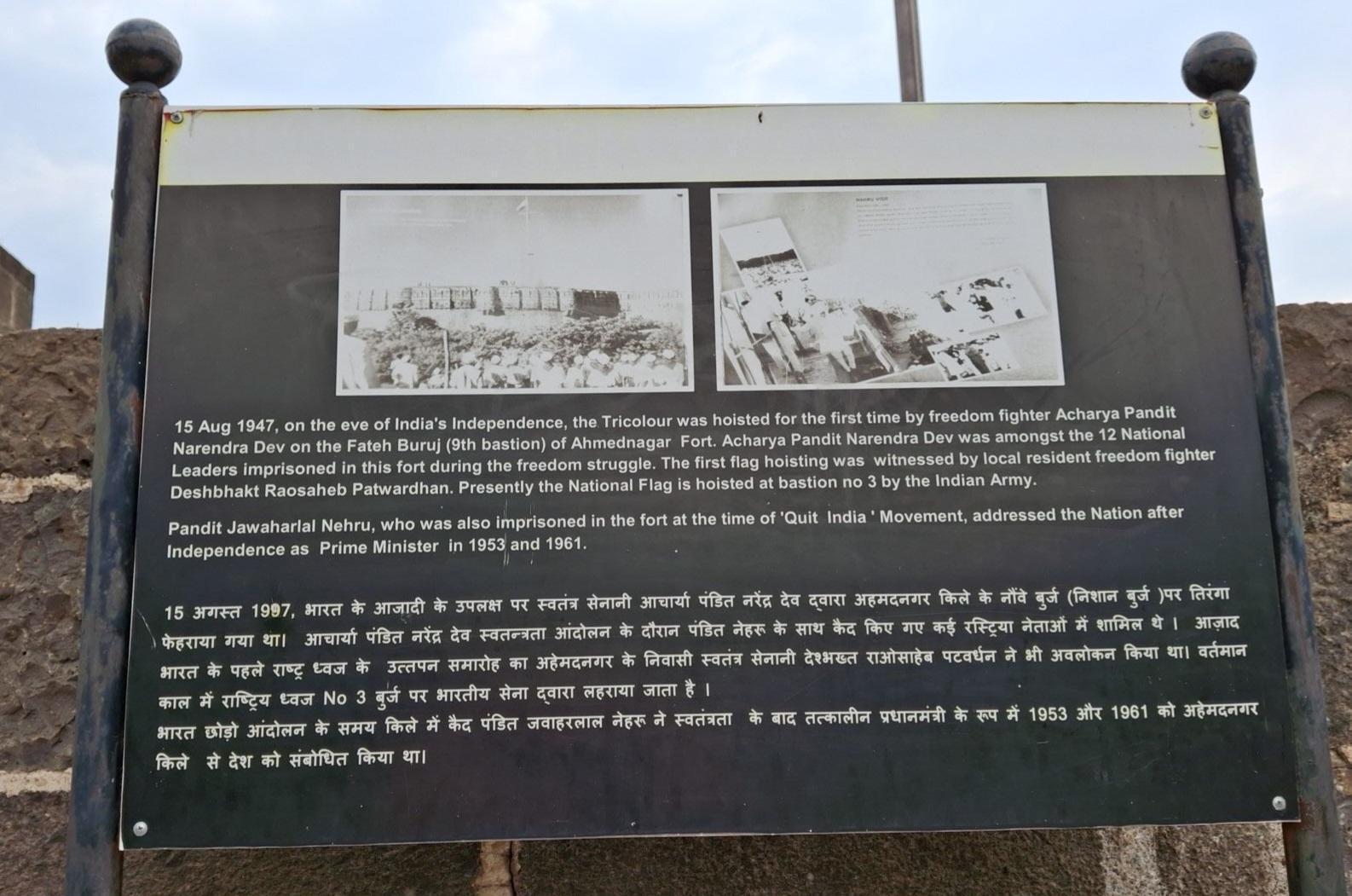

Currently, the Leader’s Block and the fort are maintained by the Armoured Corps Centre and School (ACC&S) basic training regiment. The fort is located approximately 2.4 km from the Maliwada bus stand.
Bagh Rauza
Bagh Rauza is the mausoleum of Ahmad Nizam Shah (ruled from 1490-1510 CE), the founder of the Nizam Shahi dynasty and Ahmednagar city. After declaring independence from the Bahmani Sultanate of Gulbarga in 1490, Ahmad Shah established the Nizam Shahi kingdom, naming its capital Ahmednagar after himself.

Located on the northeastern outskirts of Ahilyanagar along the Sina River, the tomb complex is considered one of the finest architectural examples of the late Bahmani and early Nizam Shahi period. The square complex is enclosed by a high boundary wall with entrances on three sides (north, east, and south). The central mausoleum, elevated on a high platform, is constructed primarily of basalt stone, topped with a white-plastered hemispherical dome built of brick and lime mortar. Inside, the tomb is inscribed with verses from the Quran in gold letters.
Despite its historical significance, Bagh Rauza is challenging to access due to a lack of signboards indicating the way to the monument. According to local residents, the site lacks proper signage and road infrastructure, while encroachments have affected the monument's grounds. Notably, they say that these factors contributed to reduced visitor numbers at this historical site.
Cavalry Tank Museum
The Cavalry Tank Museum was established by the Armored Corps Center and School in Ahilyanagar in February 1994. It is said to be the only museum of its kind in India and houses around fifty exhibits of vintage armored fighting vehicles.

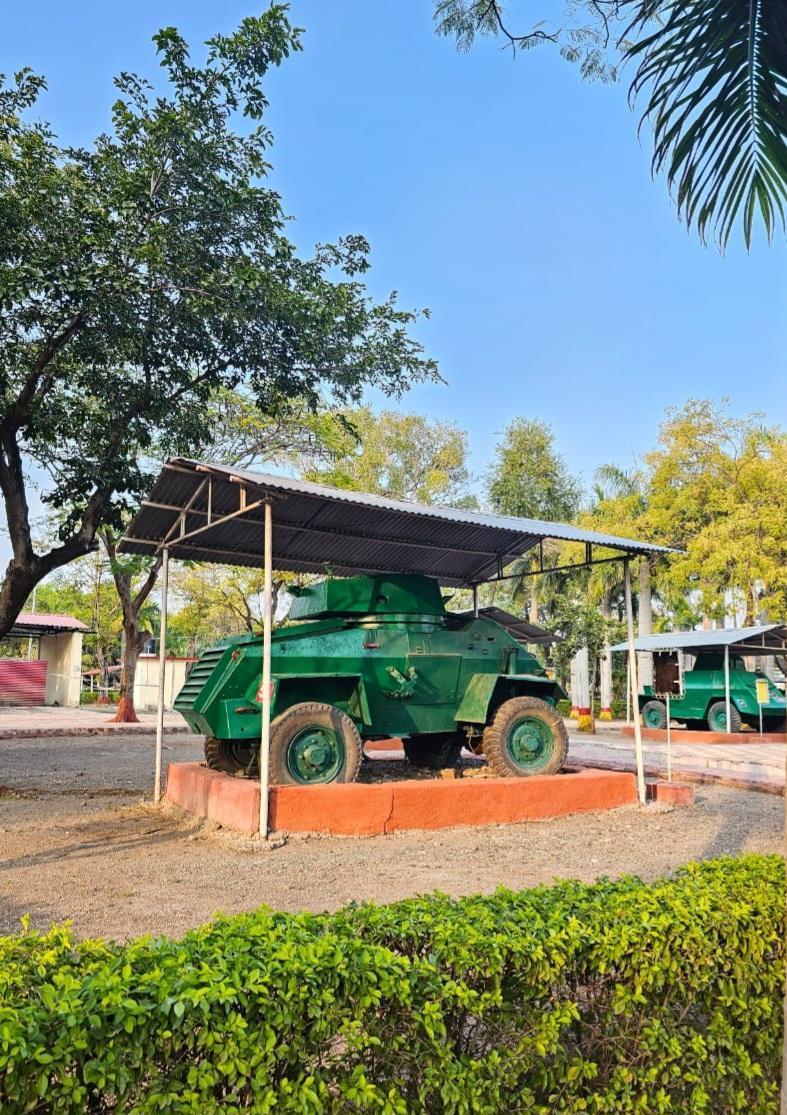
The museum’s collection showcases military vehicles from the early 20th century to the modern era, with its oldest exhibit being a 1914 Silver Ghost Rolls Royce armored car. The World War I collection includes vehicles used in significant battles at Cambrai, Somme, and Flanders. World War II vehicles form a substantial part of the collection and the museum also houses vehicles deployed during the Indo-Pakistani Wars of 1965 and 1971. The most recent addition to the collection is the Vijayanta Tank, which served as one of the main workhorses of the Indian Armed Corps for many years.
Chirki-Nevasa Archaeological Site
Chirki-Nevasa is an archaeological site located approximately 3 km north of Nevasa town in Ahilyanagar. The site is significant and very interesting, for it was here that traces of early human habitation in the region were uncovered.
Archaeologists have found many stone tools at Chirki-Nevasa, including handaxes and cleavers. These tools belong to the Acheulian era (a prehistoric period when early humans, like Homo erectus and early Homo sapiens, made more advanced stone tools than before). Experts Z.D. Ansari, M.L.K. Murty, and R.S. Pappu studied these artifacts and believe that early humans lived in the area, using resources from the Pravara River basin. The findings at Chirki-Nevasa undeniably provide crucial insights into early human activities in the region and in many ways unravel the story of prehistoric settlements in the Indian subcontinent.
Dhokeshwar Caves,Takli
Takli Dhokeshwar Cave is a rock-cut Mandir complex located in Takli village. Its origins are believed to date back to the mid 7th century. The caves are situated approximately 40 km from Ahilyanagar city along the Nagar-Kalyan road, with the Mandir located 4 km from Takli Dhokeshwar village atop a hill, accessible by a flight of stairs.
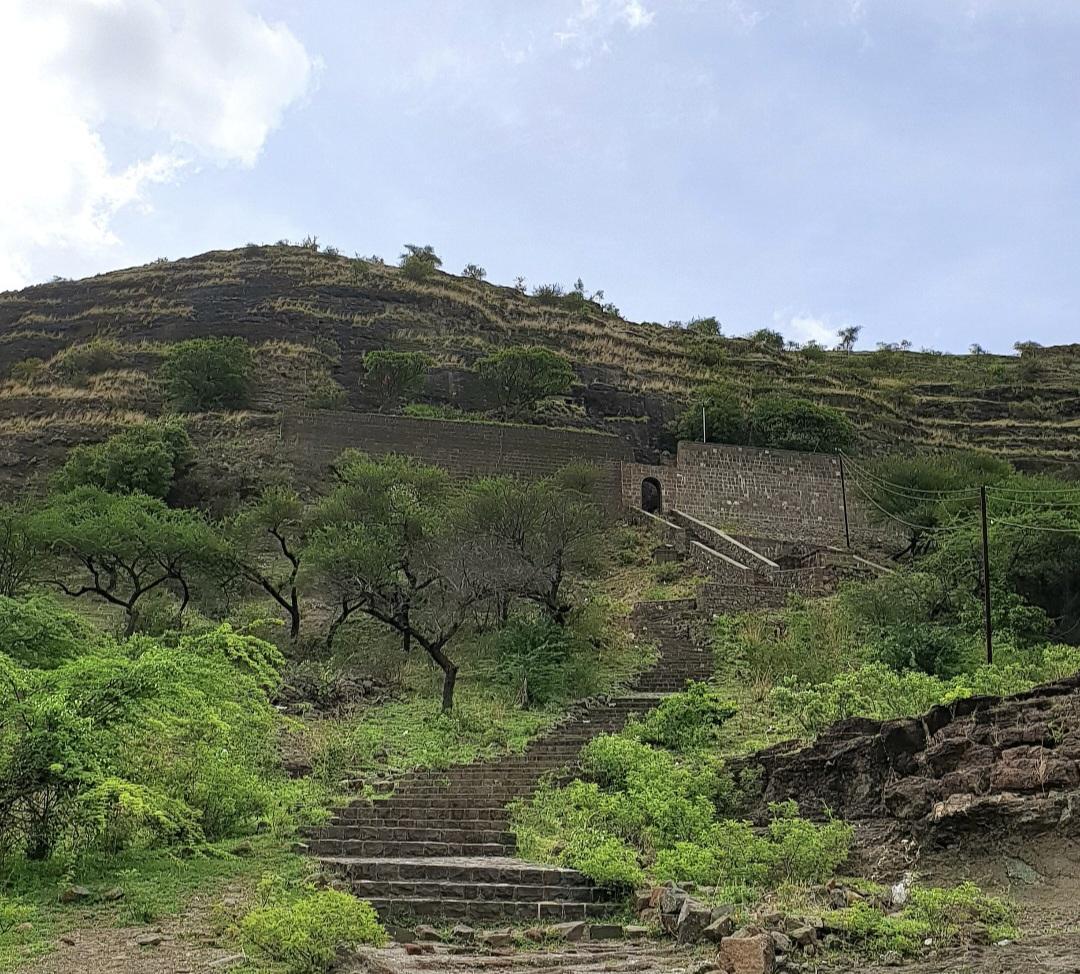
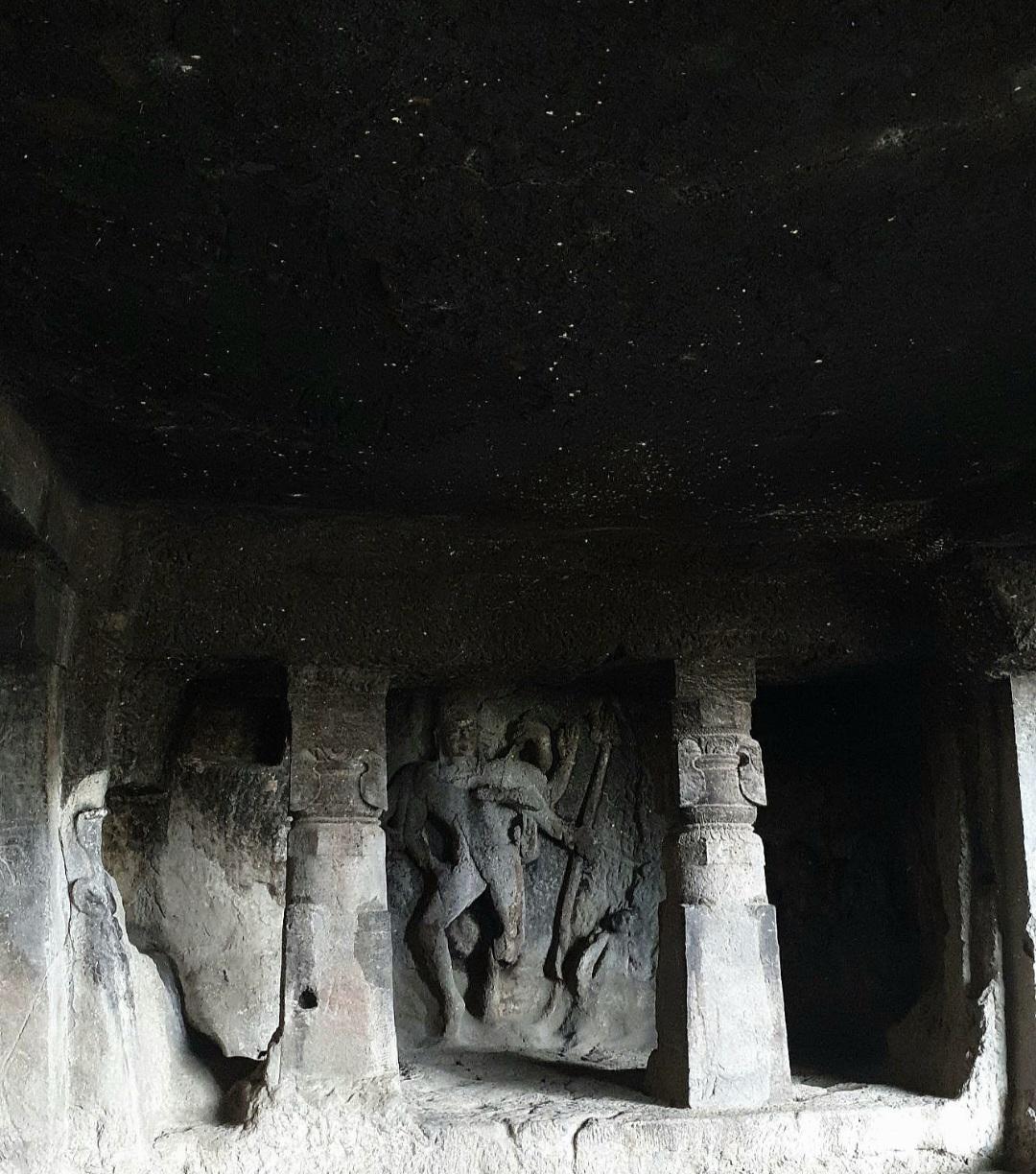
The walls are believed to feature many beautifully carved depictions of devtas and devis from the Pandavas’ era. These include Shri Ganesh, Bhairav, Mahadev, Sahamata, Tandaveshwar, Ashtasiddhi, and others. A large murti of Nandi, measuring 10 ft. in length and 5 ft. in height, is sculpted here as well. Notably, the murti is associated with an interesting local legend.
According to local folklore, that on the night of Shivaratri, placing a hand on the back of the Nandi would result in receiving ‘nanne’ (gold coins), which pilgrims were expected to use for the yatra held at the site. This belief attracted many visitors. However, over time, people began taking the coins home instead of using them for the yatra, leading to the belief that the Nandi no longer grants the coins.
Farah Baksh Mahal
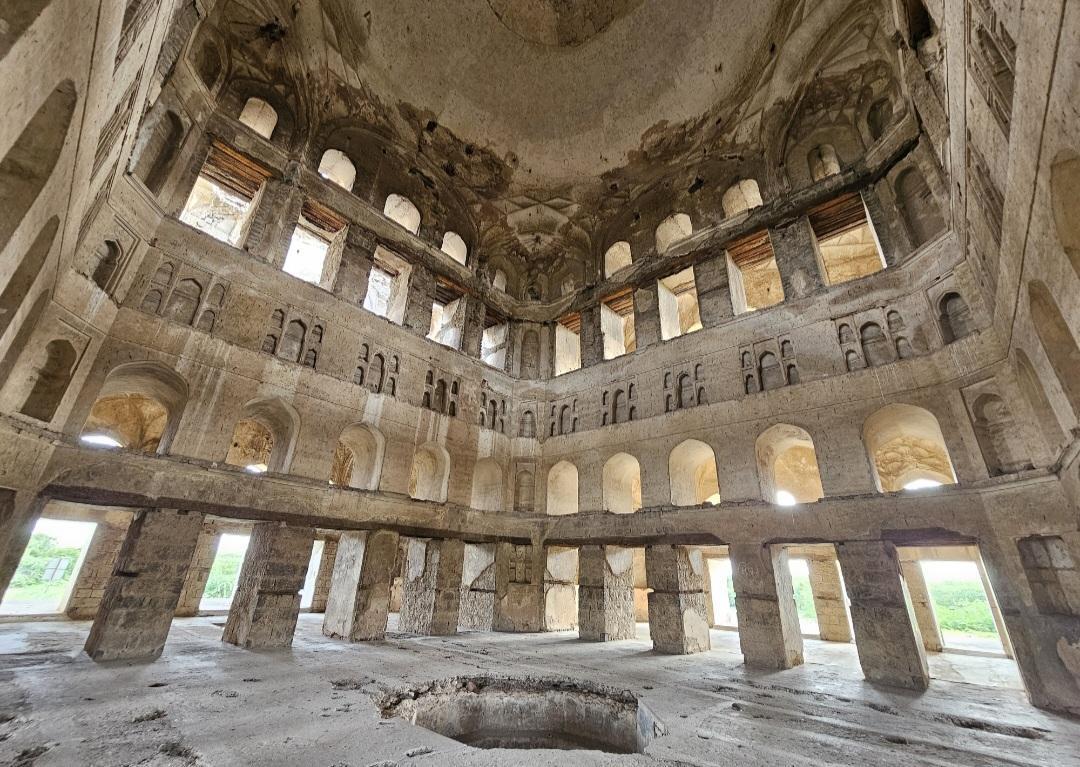
Farah Baksh Mahal (also Farakh Baksh jalmahal) is a 16th century water palace located along the Solapur road. The palace’s construction began during the reign of Burhan Nizam Shah I (1508–1553), and its story is as fascinating as its design. According to the colonial district Gazetteer (1884), the palace underwent two phases of construction.The initial structure was commissioned by the noblemen Changiz Khan and Nyamat Khan. However, the palace was soon demolished and rebuilt following criticism from Shah Tahir, a Nizari Ismaili Imam who served as minister in the Nizam Shahi court. The reconstruction was undertaken by Salabat Khan I and completed by his nephew Salabat Khan II in 1583, resulting in the structure that stands today.
The octagonal palace sits in the center of a quadrangular lake and originally featured an eastern garden. The structure comprises a central hall designed for cultural performances such as poetry, music, and dance, while the upper floors served as zenana quarters, providing secluded living spaces for the royal women. The palace’s architectural significance is evident in its grand arches and intricate carvings.
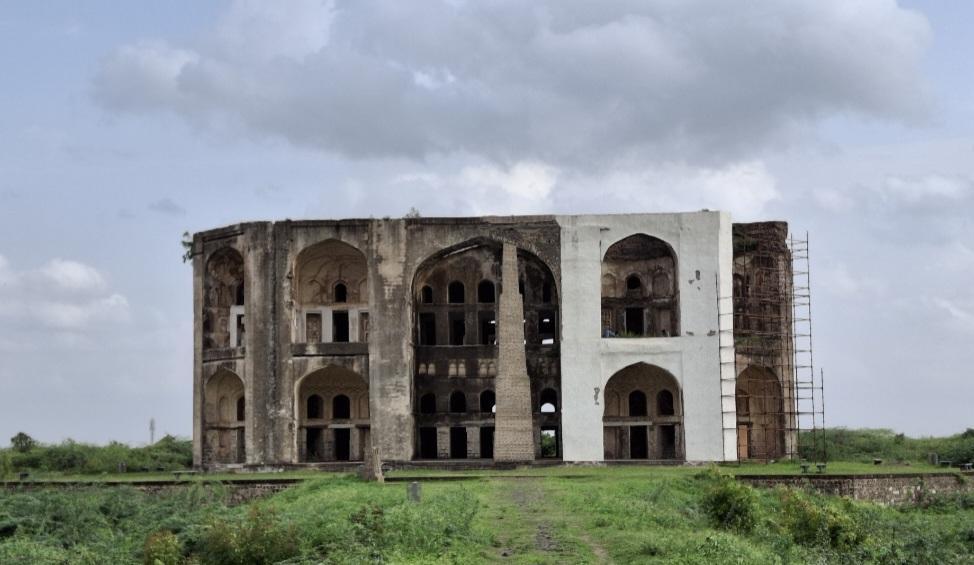
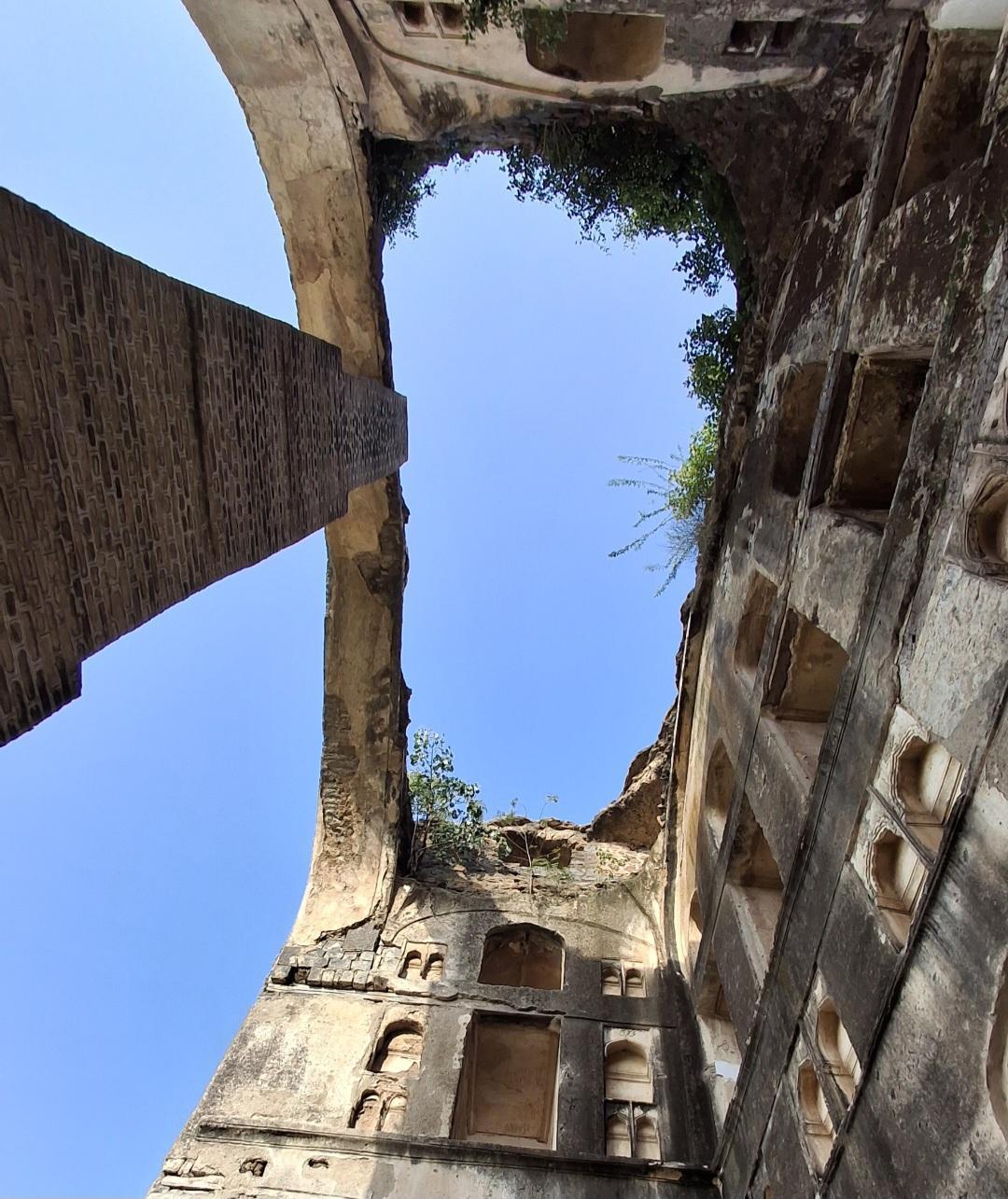
The Archaeological Survey of India (ASI) declared this monument of national importance. However, despite this, many locals point out that the structure has suffered significant deterioration over time, with collapsed sections of walls and roofing requiring urgent conservation measures.
Godad Maharaj Mandir
The Godad Maharaj Mandir is a significant cultural site which is situated in the Karjat taluka. It is dedicated to Godad Maharaj, a spiritual figure, who is often regarded as the gram devta (village patron) of the Karjat taluka. This Mandir is where the sant’s samadhi (memorial shrine) lies.
![Godad Maharaj at the Godad Maharaj Mandir of Karjat Taluka.[3]](/media/culture/images/maharashtra/ahilyanagar/cultural-sites/godad-maharaj-at-the-godad-maharaj_006JYYX.png)
Godad Maharaj was born in the Karjat taluka in 1681. It is said that he was born to a very prominent family, with his father having connections to Udaipur’s royal household. At a very young age, Godad Maharaj became a devotee of the Devta, Vitthal. He spent many years wandering beyond Karjat, each journey contributing to his spiritual growth. However, according to a local story, it was Vitthal himself who led Godhad Maharaj to return to Karjat. In this story, it is said that once, when Godad Maharaj travelled to Solapur with his dindi (procession), he faced a moment of crisis which led him to contemplate suicide.
It is said that at this critical juncture, Vitthal appeared to him in disguise and urged him to return to his home and prepare to attain Sanjeevan Samadhi (the idea of voluntarily ‘renouncing’ the body while remaining in a state of meditation). When he came back, Godad Maharaj composed many books such as “Yogasiddhant,” “Jagtarak,” and worked towards the welfare of the people. The story of the encounter between Vitthal and Godad Maharaj, in many ways, resonates in the fairs and festivals that have been held at the mandir for generations. An event known as Rathotsav has traditionally been celebrated at the mandir, every year on Ashada Ekadashi (a festival that takes place on the 11th day of the waxing moon which usually falls in June or July). It is believed that, on this day, Vitthal himself would visit the Maharaj, however, this time without a disguise.
Hasta-Behasta Mahal

Originally known as Fayz Baksh Mahal, the Hasta-Behasta Mahal is situated in the middle of a now-dry lake and was constructed in 1506 during the reign of Ahmad Nizam Shah. This historical site features eight gates that are often metaphorically described as gates to heaven. It includes a ‘hammam’ (communal bath house) designed for optimal ventilation and natural light, supplied with water from Pimpalgaon and Shendi through underground pipes.
The area also boasts a beautiful rose garden that was frequently visited by Murad, the son of Emperor Akbar, who resided here. Inside the wooden palace, there are quarters for important officials, including women of royal connections.
Historical Museum & Research Centre
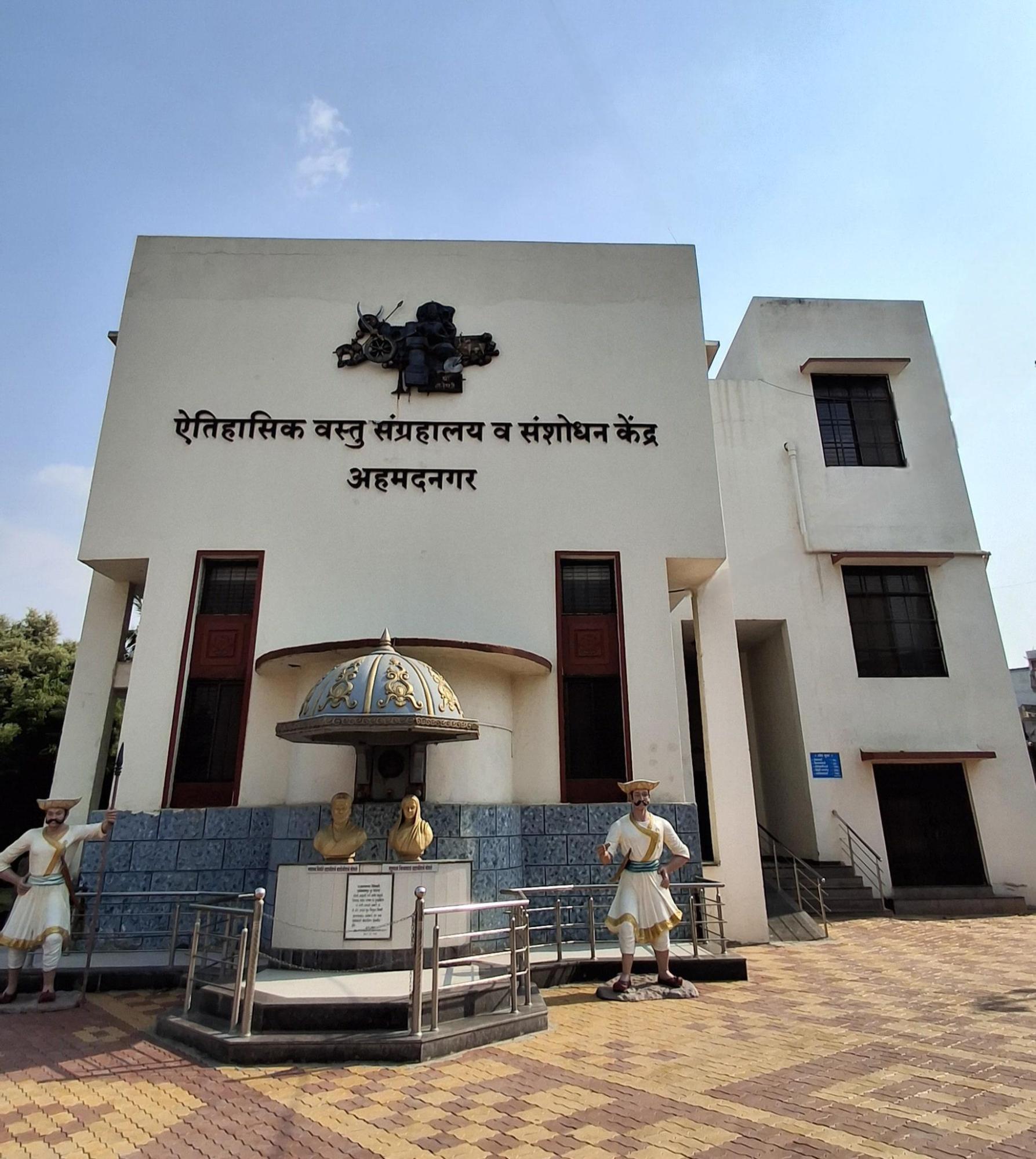
The Historical Museum & Research Centre in Hatampura was established on 1 May 1960. It houses an extensive collection of over 50,000 rare documents, 15,000 books, manuscripts, copper plates, weapons, antique utensils, sculptures, a coin collection, and numerous other ancient artefacts. Each item offers a glimpse into the lives and cultures of people from centuries past, collectively forming a rich narrative of Ahilyanagar’s history.
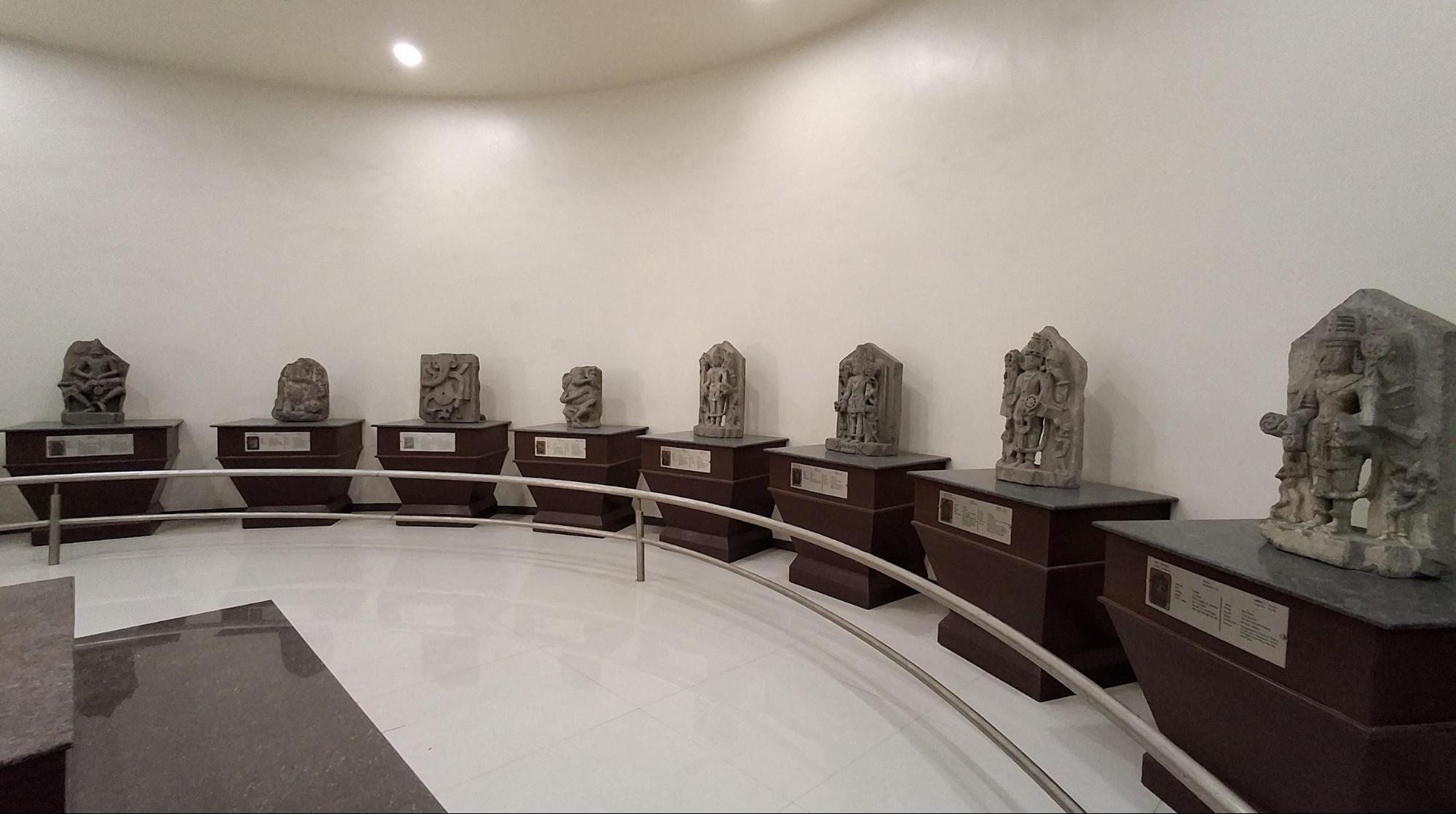

The museum spans two floors. The first floor features beautifully carved stone sculptures made of Gargoti (meaning pebbles in Marathi), dating back to the 6th and 7th centuries. In addition, household items, accessories, and utensils used by people in the past are displayed here.


On the second floor, visitors can explore a diverse array of weapons, a rare coin collection, authentic paintings, vintage and antique items, scriptures, and maps, enriching the museum's offerings and deepening the understanding of the region’s heritage.
Hume Memorial Church, Ahilyanagar
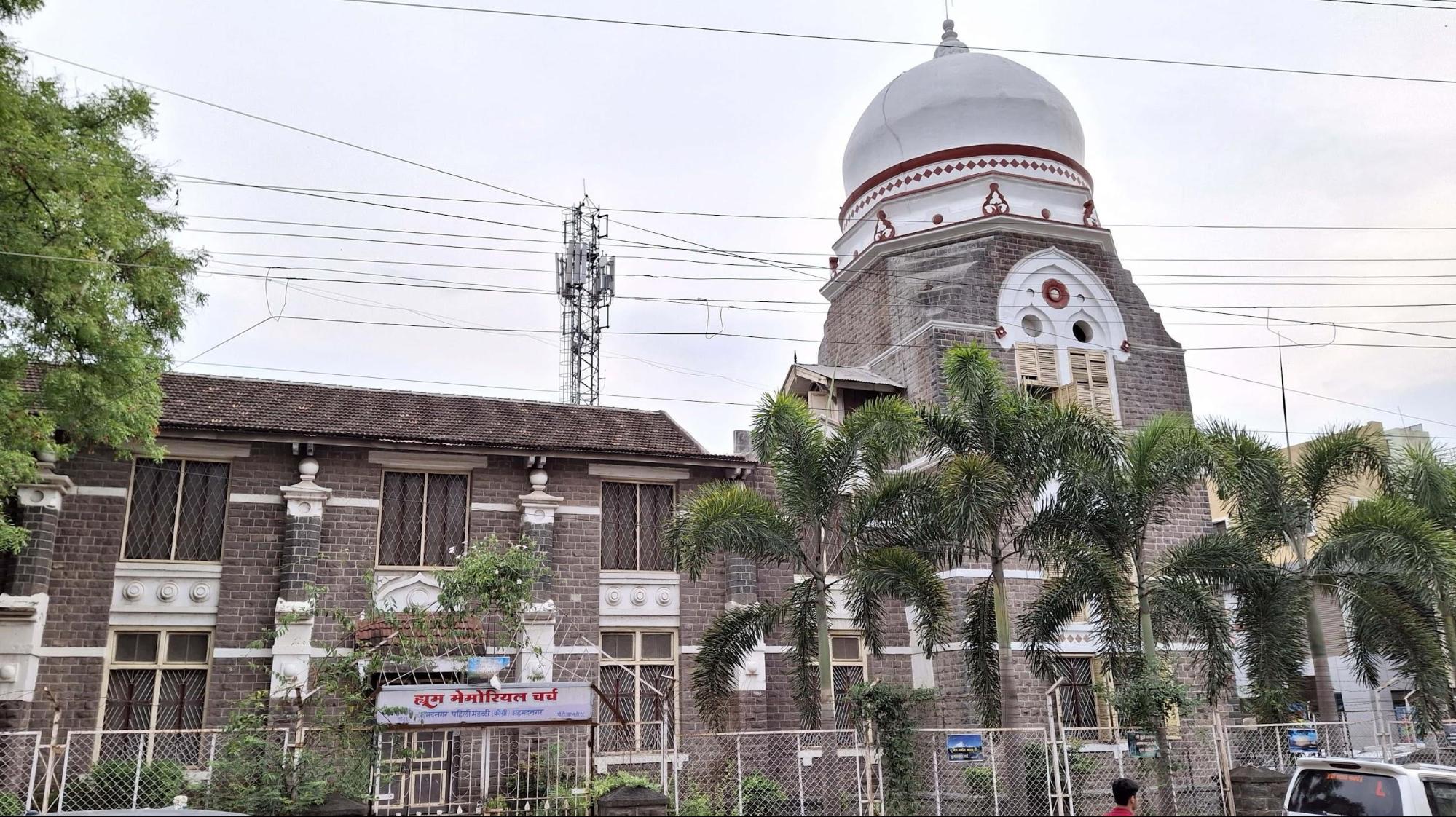
The Hume Memorial Church is a historic Presbyterian church located in the Khisti Galli area of Ahilyanagar. Built between 1902 and 1906, it was named after Rev. Dr. Robert Allen Hume, who was one of the first American missionaries who arrived and settled in the region.
The church’s origins trace back to 1831, when American missionaries arrived in Ahilyanagar, a period that led to the district being called the ‘Jerusalem of Maharashtra.’ Their work resulted in the establishment of the Ahmednagar Pahili Mandali (Congregational) and two initial places of worship. The first church, built in 1833, soon proved inadequate as the community grew, struggling to accommodate the eager congregants drawn to its doors. The first church, constructed in 1833, proved insufficient for the growing congregation, leading to the construction of this church.
Architecture
The architecture of the church is striking. The interior features Sangwan (teak) wood throughout the building, demonstrating the craftsmanship of the era. The seating arrangement spans two floors with wooden benches, accommodating 1,300 devotees. The interiors of the church are further embellished with beautiful lotus flower stained glass windows, which is said to symbolize the spiritual journey of humanity.
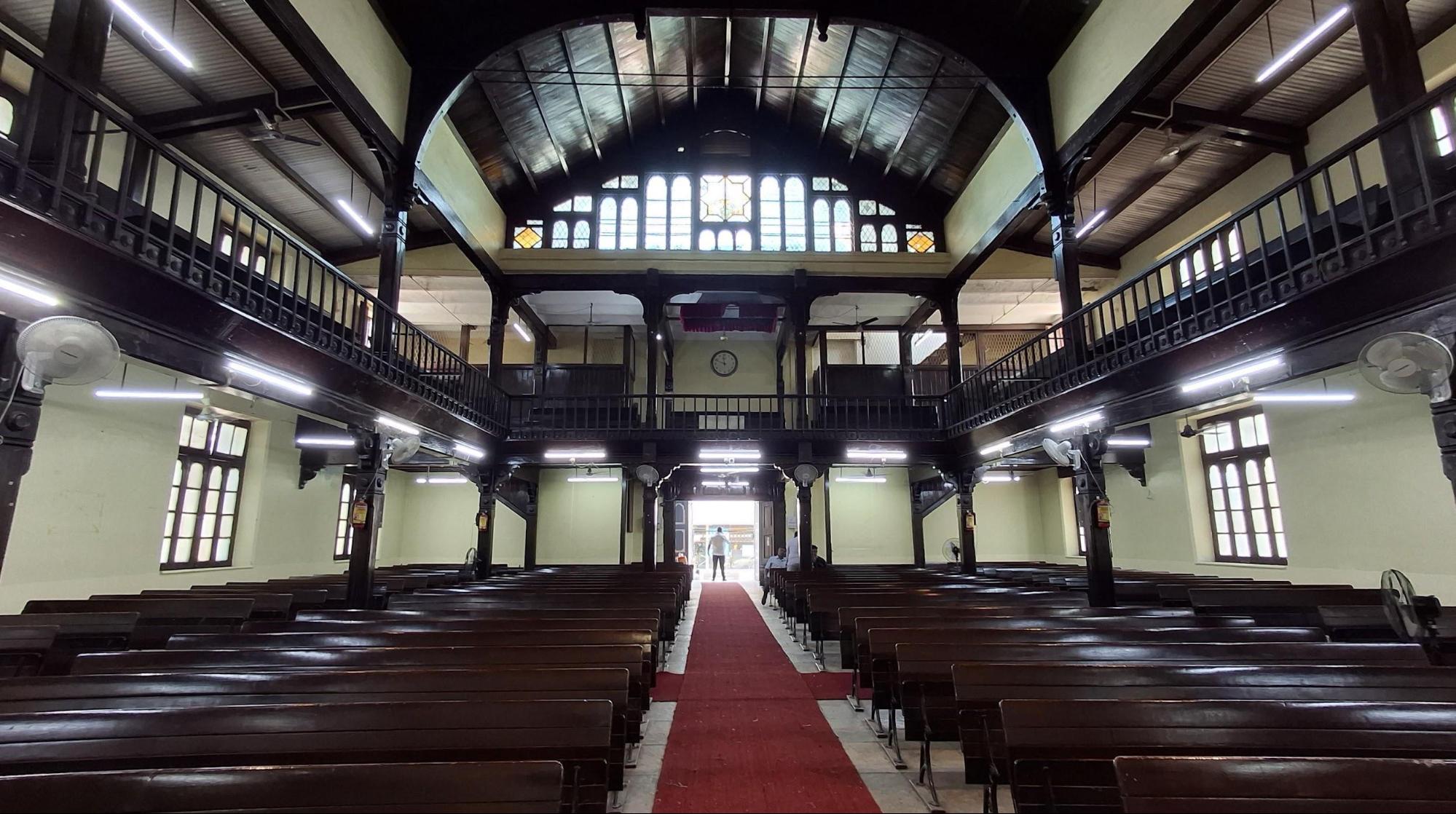

On the top floor rests an old bell, crafted in 1914 by the Meneely Bell Co. Interestingly, this bell has only been rung once. It is widely believed that the bell’s sound was so powerful that it shattered the windows of nearby buildings, leaving it unused ever since.

The church is situated approximately 2 km away from the Maliwada bus stand, making it accessible to visitors.
Jagdamba Devi Mandir, Rashin
The Jagdamba Mata Mandir is a Hemadpanthi style-mandir (an ancient architectural style) which is situated in Rashin village of Karjat taluka.
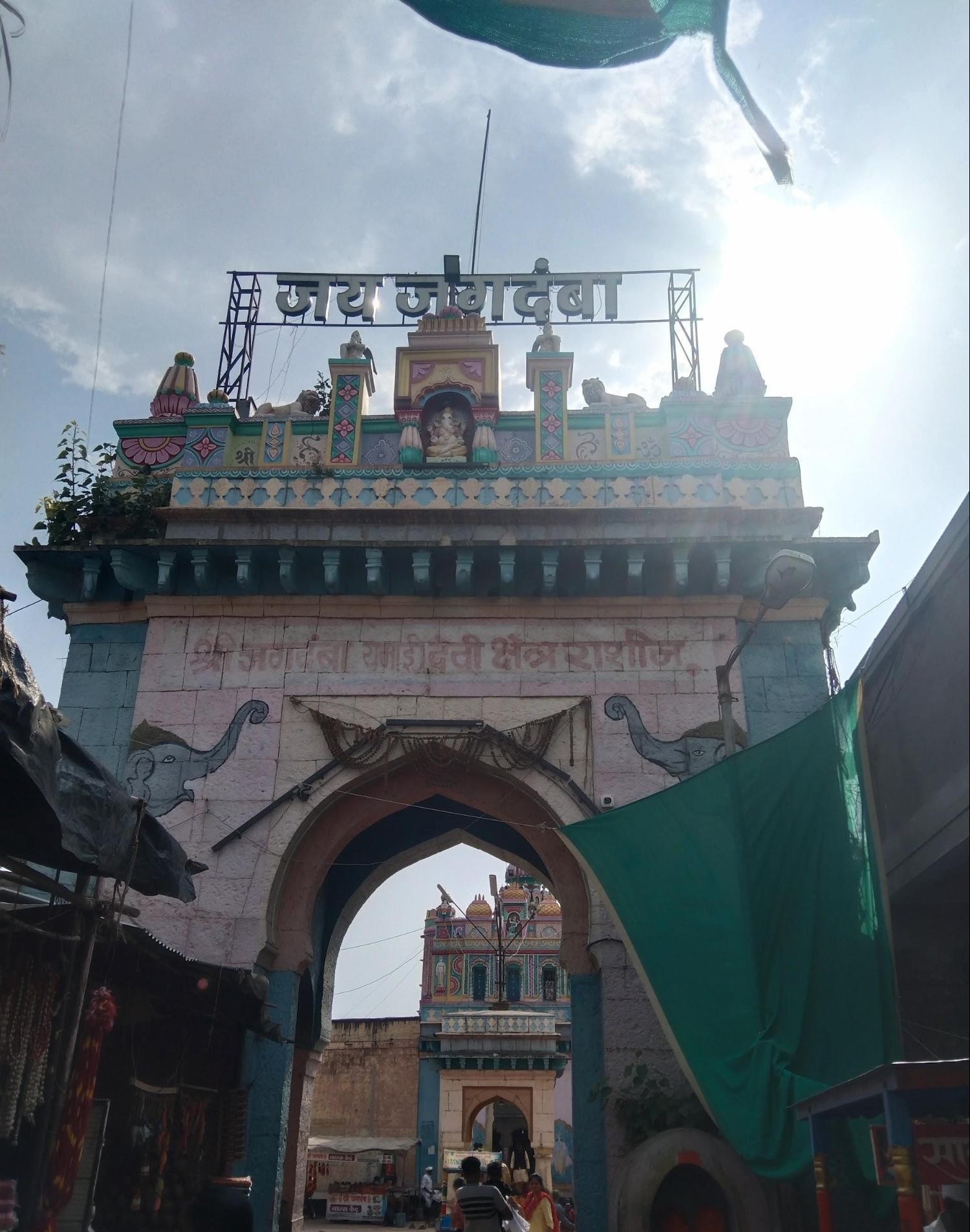
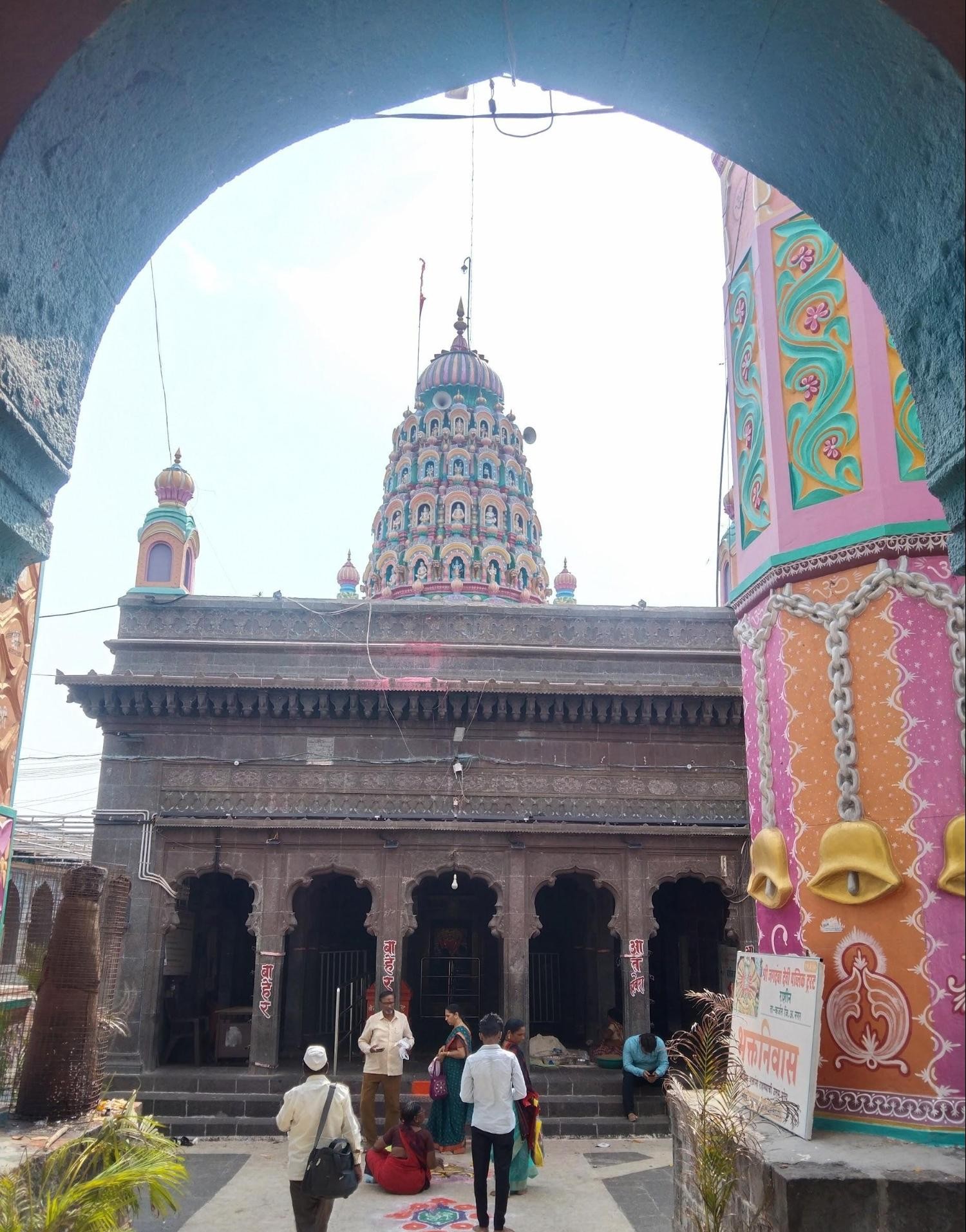
The Mandir hosts festivals such as Navratri, Vijayadashami, and Kojagiri festivals, which are notably celebrated grandly.
Kal Bhairavnath Mandir
Agadgaon Kal Bhairavnath Mandir is a historic Mandir that is situated in the village, Agadgaon. Fascinatingly, the Mandir’s construction is attributed to three asurs, Agadmal, Radatmal, and Devmal, whose faces are carved at the entrance as guardians of the structure. The Mandir is dedicated to Kal Bhairav, a form of Shiv associated with destruction and death and Jogeshwari Mata.
![Kal Bhairav and Jogeshwari Mata at the Kal Bhairavnath Mandir of Adadgaon.[4]](/media/culture/images/maharashtra/ahilyanagar/cultural-sites/kal-bhairav-and-jogeshwari-mata-at_RDPhL8z.jpg)
A jatra (weekly religious fair) is held every Sunday following Chaitra Purnima (full moon), where ‘Amti Bhakri’ is distributed as prasad. The Mandir holds special significance for the Aghori sect, a monastic order of Shaivite sadhus who follow the tantric, non-Puranic form of Shaivism and consider Kal Bhairav their principal Devta.
A unique tradition that is associated with the Mandir is a jatra known as the ‘Bhutanchi Yatra’ (which literally means the procession of ghosts or spirits). Interestingly, it is believed that alongside the humans, even the deceased come to worship Kal Bhairav. Hence, a day after a yatra arranged by the villages which takes place on Sunday, the Mandir and surrounding area become completely deserted. Villagers usually stay inside their homes, due to this local belief.
Kashi Vishwanath Mandir, Dhorja
Kashi Vishwanath Mandir is located in Dhorja, a village in Shrigonda taluka. It is believed that the Mandir was built during the rule of the Yadava dynasty (ruled from 12th to 14th century). Interestingly, although the Mandir is dedicated to Vishwanath (another form of Bhagwan Shiv), locals often refer to the Devta here as Kashinath (another form of the Bhagwan).
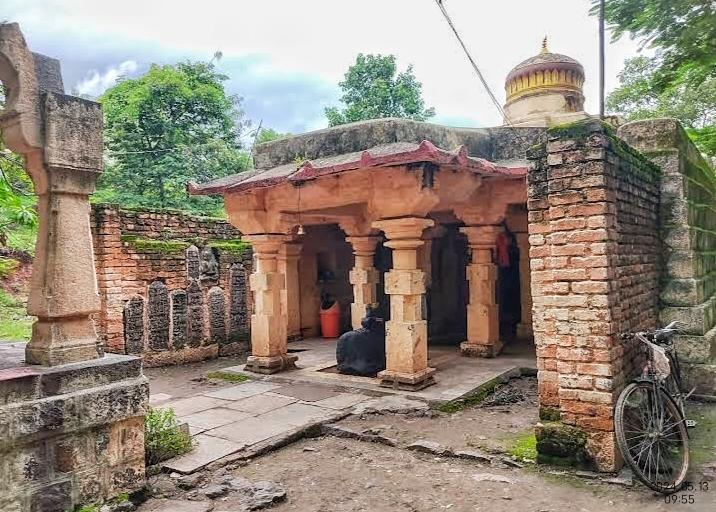
There is a very peculiar story which is tied to the location of the Mandir. According to local beliefs, a very devoted follower of Kashi Vishwanath once lived in a village near Dhorja. The devotee would visit the Devta’s Mandir regularly despite its far distance. However, as he grew older, his age made it increasingly difficult for him to travel far. The devotee prayed desperately for the devta to come to his village. Vishwanath agreed, but with one condition. The devta insisted that while he will follow the devotee to his village,the devotee must not look back at him during their journey. Unfortunately, as per the story, upon reaching Dhorja, the devotee turned to look behind him, causing the devta to remain in that location forever.
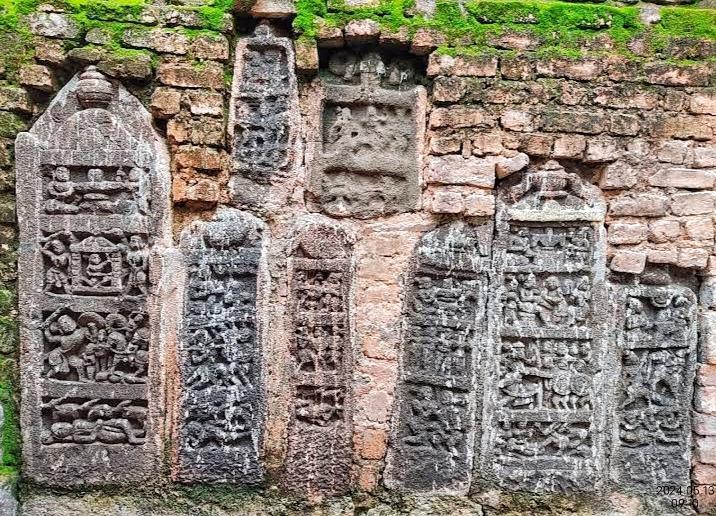
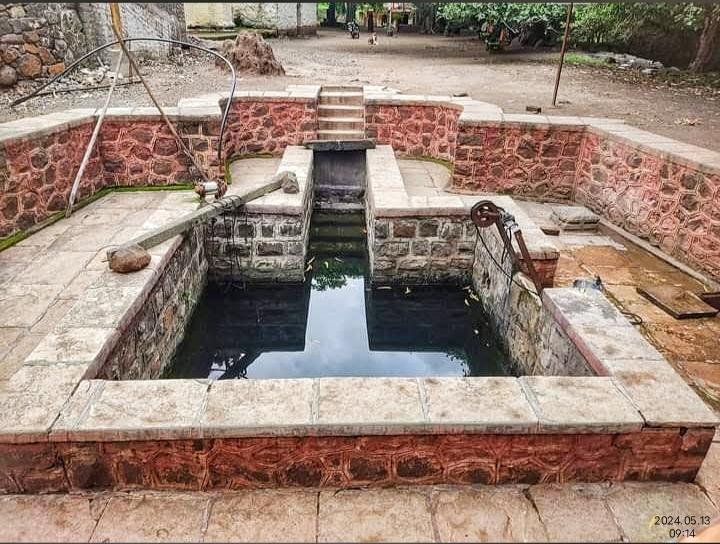
The Mandir complex houses many structures that can be of interest to archaeologists and history enthusiasts. Most notably, there are many veergals (memory stones which were usually made for warriors during the pre-medieval era) which can be found within the mandir complex. There is a barav (stepwell) which is situated nearby. The water, in the barav, remains filled with water year-round. Therefore, many locals believe that the barav will never run dry.
Madhi
Madhi is a village in the Pathardi taluka of the district, notable as the site where Shri Kanifnath attained Samadhi. Kanifnath was one of the Navnaths (Nine Nath Masters), who were influential yogis in the medieval Nath tradition of Shaivism. The village hosts a significant yatra from Holi to Gudi Padwa, with the Gopal community traditionally entrusted with lighting the sacred Holi fire.
![The Kanifnath Mandir at Madhi, Ahilyanagar.[5]](/media/culture/images/maharashtra/ahilyanagar/cultural-sites/the-kanifnath-mandir-at-madhi-ahil_I90hks2.png)
Madhi is also famous for its bustling donkey bazaar, where people from across Maharashtra come to buy and sell donkeys. Additionally, the village hosts a ‘jaat panchayat’, a community court that resolves disputes and administers justice for nomadic groups. It serves as an important religious site for vaidus (ayurvedic practitioners) throughout India. Notably, locals say that over 7 lakh devotees of Nath-bhakti visit Madhi on Phalgun Vadya Panchami (Rang Panchami).
Pemgiri Banyan Tree, Sangamner
The Pemgiri Banyan Tree, situated in the Pemgiri village of Sangamner, is often referred to as the largest Banyan tree of Maharashtra and the second largest in India. The tree sprawls across more than two acres of land and is said to have at least 90 prop roots. It is estimated to be around 250-300 years old.
The tree is considered by the locals to be very sacred. There is a very interesting local lore which is tied to the tree. According to the lore, a guardian spirit named Jakmat Baba, has for long, protected the tree. There is a warning that is often recited by locals, which says that anyone who harms the banyan tree will face severe consequences from Jakmat Baba. Notably, beneath the tree’s extensive canopy, there is a small shrine which is dedicated to the Baba. It is said that the axe of the Baba was once visible in the trunk of this Banyan tree. However, as the trunk grew over the years, the axe, today, no longer remains visible.
Salabat Khan’s Tomb
Salabat Khan’s Tomb is a historical mausoleum dedicated to Salabat Khan II, the notable minister of Murtaza Nizam Shah I (1519-1589). Often mistakenly referred to as ‘Chand Bibi Mahal,’ this architectural monument stands at an elevation of 3,080 ft. above sea level on the Shah Dongar plateau in Ahilyanagar.

The structure is a three-storeyed octagonal building constructed of stone. The ground floor houses the graves of Salabat Khan II and his first wife, while his second wife and a dog are buried in the courtyard of the structure. A popular saying often recited by locals today speaks of the monument’s grandeur. It is that the monument was originally going to be eight storeys high and from the eight storey Delhi was going to be visible. The district colonial Gazetteer (1884) contains a different account of this saying. It notes that, “according to one account Salabat Khan meant to carry up the tower, till from the top of it he could see his beloved Daulatabad.”
Notably, there are many intriguing legends that are associated with the tomb. One such legend recorded in the colonial Gazetteer (1884) is associated with the tomb’s unfinished state. It is said that Salabat Khan II, possessed the secret of the philosopher’s stone and quite like King Midas of the Greek legends, knew “the art of turning base metal into gold.” Over time, he grew weary of life and constructed the tomb for himself. One day, he prepared three cups of poison, offering them to his two wives. However, only one drank. To the wife who drank the poison, as noted in the Gazetteer, “he assigned the honour of being buried by his side within the tomb. The other wife was buried with her child outside the tomb on the terrace.”
Other than the legends, the site also holds an intriguing history as a medical facility during the British Raj, specifically serving the Nagar Brigade. During the British Raj, Captain Pottinger, the first Collector, established his camp at the site and made several modifications, including sealing an arch and constructing an access road. In 1859, the British military converted the structure into a convalescent (nursing) facility, modifying the first and second floors to accommodate fifty military personnel from the Nagar Brigade. The Gazetteer documents that the Superintending Surgeon noted that the hill’s modest elevation made it unsuitable as a true health resort, however, it proved beneficial for recuperating soldiers during the hot season.
Interestingly, the site also has an earlier medical history. It is noted that before British rule, the tomb was occupied by a fakir who was “skilled in medicine,” highlighting one of the lesser-known aspects of the site’s rich history.
Shiv Mandir, Vriddheshwar
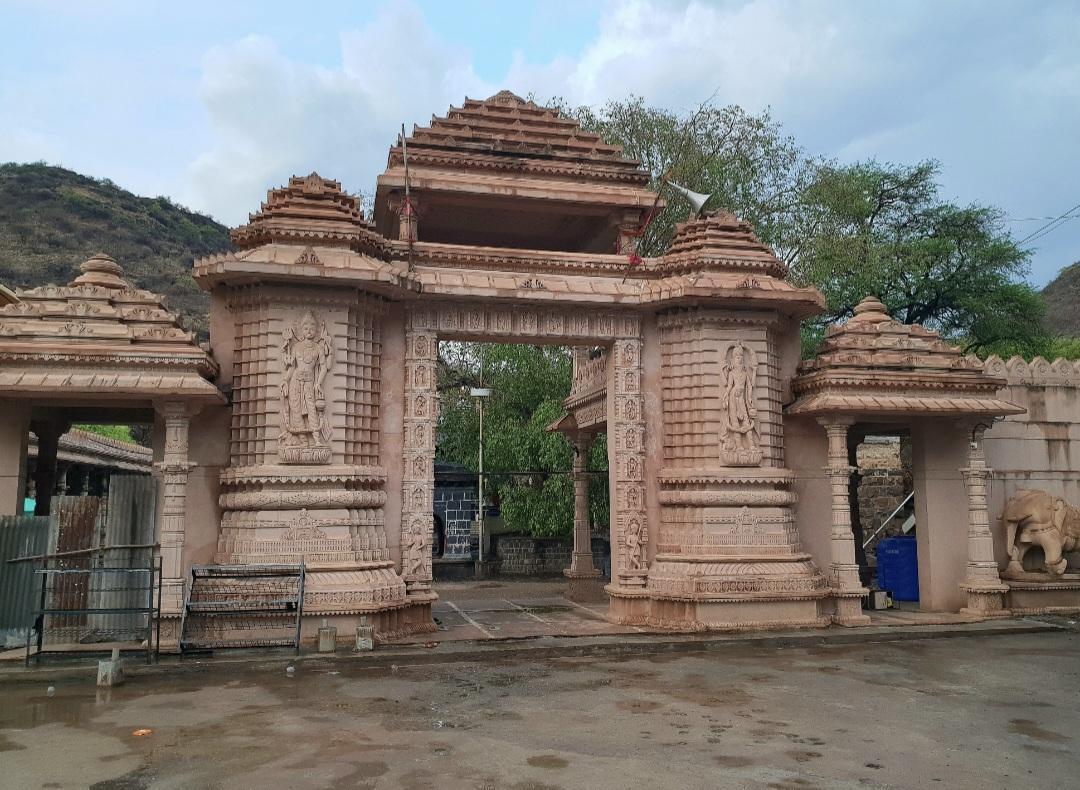
The Shiv Mandir, situated in Vriddheshwar village is an ancient site that holds much religious and cultural significance for the local community. The mandir is dedicated to what locals believe is Mhatardev, another form of Bhagwan Shiv.
The story of Mhatardev is interesting. It is said that years ago, Devi Parvati is said to have performed penance and served food to the devis and devtas at the Garbhagiri hill, which notably, lies adjacent to the mandir. According to a local lore, it is during this time that Bhagwan Shiv appeared as an elderly man and miraculously increased the food offerings for all devis and devtas. This is why, locals say that the devta revered here is known as Mhatardev. Additionally, it is believed that the Shivling at this mandir continuously grows.
Shri Datta Mandir
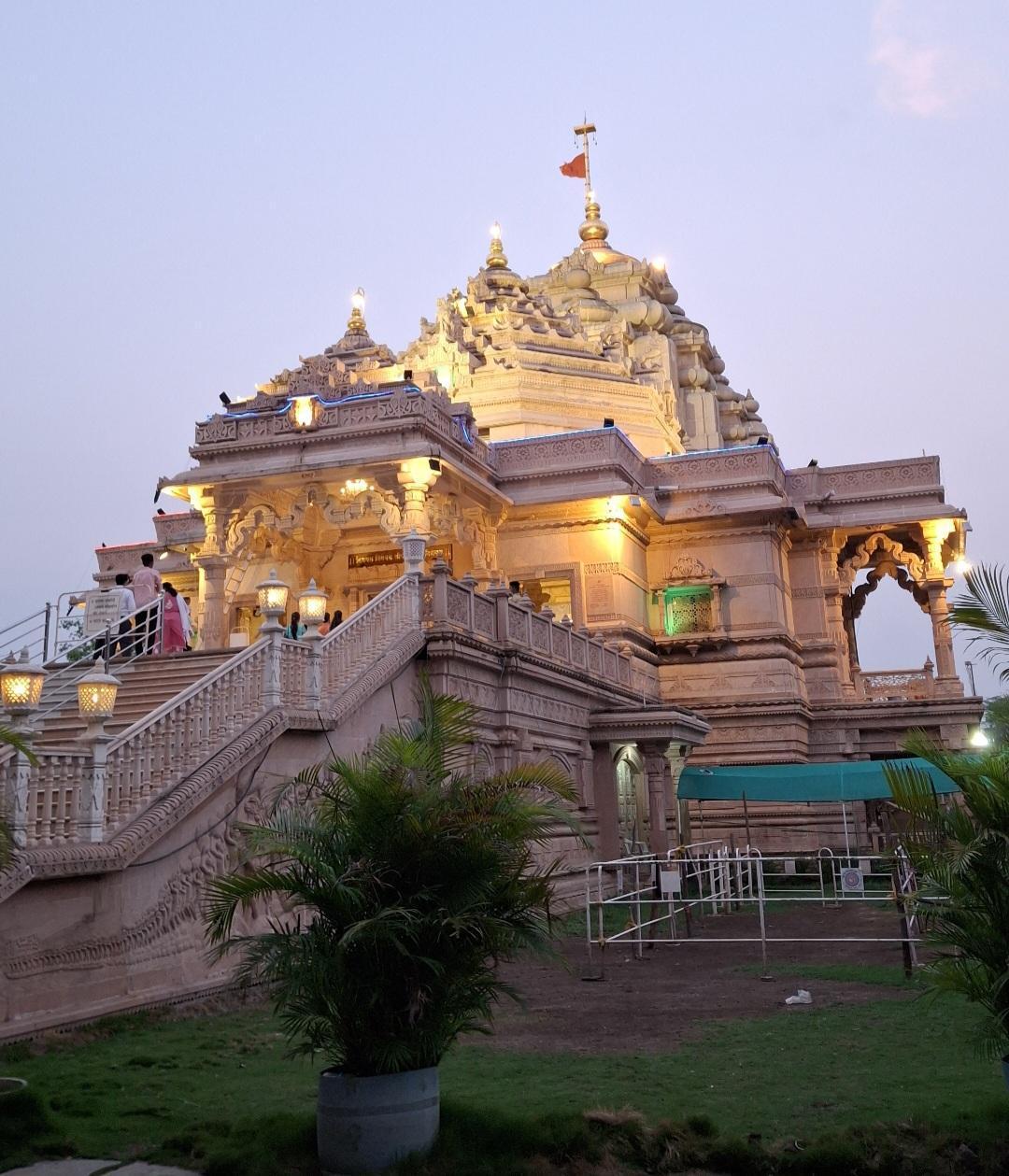
The Datta Mandir, located near Premdan Chowk in Savedi is believed to be the largest Datta mandir in India. Although recently constructed, it stands as a magnificent architectural marvel entirely built from Gulabi Bansi Paharpur Dagad (Rajasthani stone). The intricate stone carvings throughout the Mandir are exceptionally beautiful. Along the sides of the Mandir’s staircase, one can find depictions of Bhagwan Krishna lifting Mount Govardhan on his finger, as well as images of Hanuman and the Vanar Sena constructing a bridge of rocks.

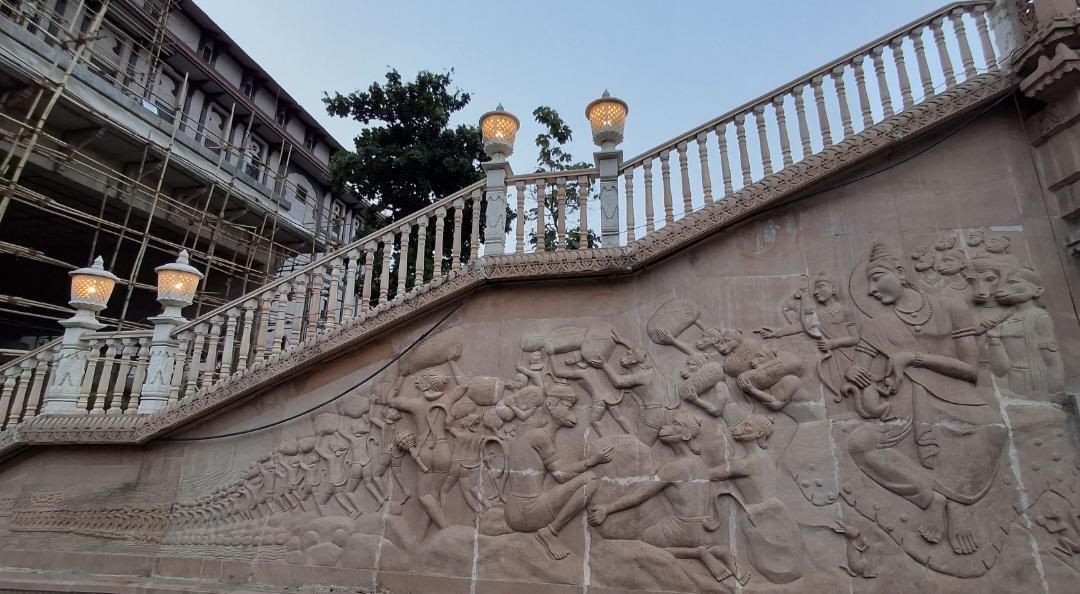
The Shri Datta Devasthan, established in 1974 by Shri Ramakrishna Kshirsagar Swamiji, oversees the Datta Mandir. Swamiji’s mission was to protect and preserve the Vedas and to share the philosophies of Vedanta and its benefits with all of humanity. Notably, the Mandir houses the paduka of Shri Ramkrishna Kshirsagar Swamiji.
Shri Sai Baba Mandir, Shirdi
![The Sai Baba Samadhi Mandir at Shirdi, Ahilyanagar.[6]](/media/culture/images/maharashtra/ahilyanagar/cultural-sites/the-sai-baba-samadhi-mandir-at-shi_quC3qNT.png)
The Sai Baba Mandir is a significant site located in Shirdi which is dedicated to the spiritual figure Sai Baba. The mandir is among the many well-known sites in Maharashtra and has become a pilgrimage site. Notably, it is said that the mandir complex receives an average of 25,000 daily visitors for darshan, with attendance exceeding 1 lakh during festive seasons.
Sai Baba’s Life and Teachings
Sai Baba was a spiritual figure whose teachings emphasized interfaith harmony. His date of birth and early life details remain unknown. However, it is known that Sai Baba spent much of the later part of his life in Shirdi. Here, he lived a simple life focused on spiritual teachings and service to others. His philosophy was centered on the unity of all religions, expressed through his saying “Sabka Malik Ek” (One God governs all).
![An image of Sai Baba.[7]](/media/culture/images/maharashtra/ahilyanagar/cultural-sites/an-image-of-sai-baba7-24906268.png)
The Mandir is a place that encapsulates this belief. People from all faiths visit the Mandir to pay respect to Sai Baba. Notably, this Mandir contains Sai Baba’s samadhi.
The Mandir preserves a range of items associated with Sai Baba, including his unique photographs, footwear, utensils, wheat grains, bedding, cot, pillow, and clothes. Interestingly, there is a local lore that is attached to the Mandir. In the earlier years that Sai Baba lived in Shirdi, he lived in a mosque called Dwarkamai. Local lore suggests that there is an underground tunnel or passage beneath the neem tree at the Mandir that leads to Dwarkamai.
Siddhivinayak Mandir
The Siddhivinayak Mandir in Siddhatek is a mandir located in Siddhatek, Karjat taluka. The mandir is one of the Ashtavinayaks (eight prominent Ganesh mandirs in Maharashtra) and is regarded as the only Ashtavinayak Mandir in Ahilyanagar district, making it a significant yatri site.
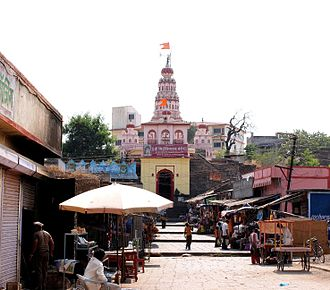
The Mandir is considered to be a ‘jagrut kshetra’ and the murti is described as swayambhu. Devotees usually visit the Mandir with the belief that the devta of the Mandir is particularly powerful.
Vishal Ganpati Mandir, Maliwada
The Vishal Ganpati Mandir, located in the Maliwada area of Ahilyanagar city, which houses what many locals consider, “the gram devta of the district.” The term ‘Vishal’ in Marathi translates to ‘grand’, aptly reflecting the Mandir’s significance. Originally constructed of wood and smaller in size, the Mandir is nearly 70 ft. tall, with its ‘Kalash’ (pinnacle) easily visible from nearby areas.
The entire structure is crafted from Makrana marble, a type of white marble which was notably used to build Taj Mahal. Maintenance of the Vishal Ganpati Mandir is overseen by the Maliwada Panch Mandal Devasthan trust.


Though the exact date of establishment remains uncertain, the Mandir is estimated to be around 400-450 years old. Daily aarti, performed according to the Nathpanthi parampara, takes place in the evening.
Notably, among the 12 ‘Manache Ganpati’ (a term used for the most venerated Ganesh mandals across Maharashtra) visited by devotees during Ganesh Utsav, it is said that the Vishal Ganpati Mandir holds the top position on the list. On the first and last days of the festival, the District Magistrate and Superintendent of Police of Ahilyanagar conduct the aarti at the Mandir.
Sources
Gazetteers of the Bombay Presidency. 1884 (Reprinted in 2003, e-Book Edition 2006).Gazetteers of the Bombay Presidency: Ahmadnagar District, Volume XVII.Gazetteer Department, Government of Maharashtra, Mumbai.
Maharashtra State Gazetteers. 1976. Ahmadnagar District.Gazetteers Department, Government of Maharashtra, Mumbai.
Makrana Marble India. International Commission on Geoheritage.https://iugs-geoheritage.org/geoheritage_sto…
News 18. 2022. Ahilyabai Holkar 297th Birth Anniversary: Interesting Facts About the Brave Queen of Malwa. https://www.news18.com/amp/news/lifestyle/ah…
Pandav Puri. 2014. Antarang Ahmednagar Jilha. शब्दगंध प्रकाशन.
Ruchira Desai Official. 2021. Agasti Rishi Ashram Akole | अगस्ति आश्रम/मंदिर अकोले. You Tube.https://www.youtube.com/watch?v=QSjG3f0X-qM
Sailendra Sen. 2013. A Textbook of Medieval Indian History. Primus Books, Delhi. p. 118.
Sarah Waheed. 2014. Whatever Happened to Chand Bibi Sultan? Narratives of a Deccan Warrior Queen. Vol 47, No. 3. South Asia: Journal of South Asian Studies.
Shree Sai Baba Sansthan Trust.‘About Us.'https://www.sai.org.in/en/about-sansthan
The Driving Addict. 2019. Sunday Family Drive to Pemgiri - The King of Banyan Trees. Wordpress.
The Faria Bagh. Archaeological Survey of India. Aurangabad Circle.https://asiaurangabadcircle.com/monuments/ah…
Tushar Pawar. 2024. Maharashtra’s Ahmednagar is now officially Ahilyanagar.Times of India. https://timesofindia.indiatimes.com/city/nas…
Vasant Charmal. 2016. Sadguru Godad Maharaj. Marathi Srushti.https://www.marathisrushti.com/articles/sadg…
Vijaysingh Holam. 2023.“राक्षसांनी बांधलेलं मंदिर अन् भुतांची जत्रा; नगरच्या गावातील अनोखी प्रथा माहितेय का?” Maharashtra Times.https://marathi.indiatimes.com/maharashtra/a…
Z. D. Ansari, M. L. K. Murty, R. S. Pappu, The Acheulian Horizon At Chirki-Nevasa And Its Chronological Implications, Bulletin of the Deccan College Post-Graduate and Research Institute, Vol. 36, No. 1/4 (1976-77), pp. 8-14.
Last updated on 5 November 2025. Help us improve the information on this page by clicking on suggest edits or writing to us.